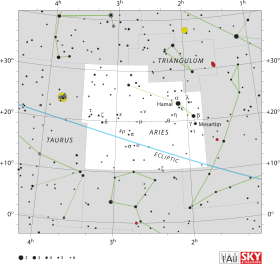47 Arietis est une étoile de la constellation du Bélier . 47 Arietis est sa désignation de Flamsteed . Elle est faiblement visible à l'œil nu avec une magnitude apparente de 5,80[ 2] parallaxe de 30,15 ± 0,30 mas [ 1] années-lumière parsecs Terre .
Elle s'éloigne du Système solaire avec une vitesse radiale de 26,6 km/s [ 5] mouvement propre est relativement élevé, traversant la sphère céleste à une vitesse de 0,237 seconde d'arc année [ 12] Hyades [ 13] , [ 14]
Li et al. étoile jaune-blanc de la séquence principale avec un type spectral F5 V(e)[ 3] étoile sous-géante [ 4] , [ 14] % de chances) de la source d'émission de rayons X détectée à ces coordonnées[ 15] [ 16] M ☉ [ 7] L ☉ [ 8] photosphère à une température effective d'environ 6 633 K [ 7]
47 Arietis a une naine rouge comme compagnon à une distance angulaire de 14,8 secondes d'arc le long d'un angle de position de 113°, en 1998. Cette étoile a un type spectral M3.5 et une magnitude apparente de bande J en infrarouge de 10,47[ 17]
↑ a b c d e et f (en) F. van Leeuwen, « Validation of the new Hipparcos reduction Astronomy & Astrophysics vol. 474, no 2, 2007 , p. 653–664 (DOI 10.1051/0004-6361:20078357 Bibcode 2007A&A...474..653V arXiv 0708.1752 S2CID 18759600 ↑ a b c et d (en) H. L. Johnson et al. UBVRIJKL photometry of the bright stars Communications of the Lunar and Planetary Laboratory vol. 4, no 99, 1966 , p. 99 (Bibcode 1966CoLPL...4...99J ↑ a et b (en) J. Z. Li et al. New discovery of weak-line T Tauri stars in high-Galactic latitude molecular clouds Astronomy & Astrophysics vol. 356, avril 2000 , p. 157–162 (Bibcode 2000A&A...356..157L ↑ a et b (en) A. P. Cowley, « Spectral classification of the bright F stars Publications of the Astronomical Society of the Pacific vol. 88, avril 1976 , p. 95–110 (DOI 10.1086/129905 Bibcode 1976PASP...88...95C ↑ a et b (en) G. A. Gontcharov, « Pulkovo Compilation of Radial Velocities for 35495 Hipparcos stars in a common system Astronomy Letters vol. 33, no 11, novembre 2006 , p. 759–771 (DOI 10.1134/S1063773706110065 Bibcode 2006AstL...32..759G arXiv 1606.08053 S2CID 119231169 ↑ (en) Olin J. Eggen, « The Age Range of Hyades Stars The Astronomical Journal vol. 116, no 1, juillet 1998 , p. 284–292 (DOI 10.1086/300413 Bibcode 1998AJ....116..284E ↑ a b c d e et f (en) Trevor J. David et Lynne A. Hillenbrand, « The Ages of Early-Type Stars: Strömgren Photometric Methods Calibrated, Validated, Tested, and Applied to Hosts and Prospective Hosts of Directly Imaged Exoplanets The Astronomical Journal vol. 804, no 2, 2015 , p. 146 (DOI 10.1088/0004-637X/804/2/146 Bibcode 2015ApJ...804..146D arXiv 1501.03154 S2CID 33401607 ↑ a et b (en) E. Anderson et Ch. Francis, « XHIP: An extended hipparcos compilation Astronomy Letters vol. 38, no 5, 2012 , p. 331 (DOI 10.1134/S1063773712050015 Bibcode 2012AstL...38..331A arXiv 1108.4971 S2CID 119257644 ↑ (en) L. Casagrande et al. New constraints on the chemical evolution of the solar neighbourhood and Galactic disc(s). Improved astrophysical parameters for the Geneva-Copenhagen Survey Astronomy & Astrophysics vol. 530, juin 2011 , article no A138 (DOI 10.1051/0004-6361/201016276 Bibcode 2011A&A...530A.138C arXiv 1103.4651 S2CID 56118016 ↑ (en) Trisha F. Mizusawa et al. Exploring the Effects of Stellar Rotation and Wind Clearing: Debris Disks around F Stars The Astronomical Journal vol. 144, no 5, novembre 2012 , p. 16 (DOI 10.1088/0004-6256/144/5/135 Bibcode 2012AJ....144..135M arXiv 1208.6248 S2CID 41406330 ↑ (en) 47 Ari sur la base de données Simbad Centre de données astronomiques de Strasbourg .↑ (en) Sébastien Lépine et Michael M. Shara, « A Catalog of Northern Stars with Annual Proper Motions Larger than 0.15" (LSPM-NORTH Catalog) The Astronomical Journal vol. 129, no 3, mars 2005 , p. 1483–1522 (DOI 10.1086/427854 Bibcode 2005AJ....129.1483L arXiv astro-ph/0412070 S2CID 2603568 ↑ (en) J. H. J. de Bruijne et al. A Hipparcos study of the Hyades open cluster. Improved colour-absolute magnitude and Hertzsprung-Russell diagrams Astronomy & Astrophysics vol. 367, no 1, février 2001 , p. 111–147 (DOI 10.1051/0004-6361:20000410 Bibcode 2001A&A...367..111D arXiv astro-ph/0011565 S2CID 55224801 ↑ a et b (en) D. Montes et al. Late-type members of young stellar kinematic groups – I. Single stars Monthly Notices of the Royal Astronomical Society vol. 328, no 1, novembre 2001 , p. 45–63 (DOI 10.1046/j.1365-8711.2001.04781.x Bibcode 2001MNRAS.328...45M arXiv astro-ph/0106537 S2CID 55727428 ↑ (en) Christian Bernt Haakonsen et Robert E. Rutledge, « XID II: Statistical Cross-Association of ROSAT Bright Source Catalog X-ray Sources with 2MASS Point Source Catalog Near-Infrared Sources The Astronomical Journal Supplement vol. 184, no 1, septembre 2009 , p. 138–151 (DOI 10.1088/0067-0049/184/1/138 Bibcode 2009ApJS..184..138H arXiv 0910.3229 S2CID 119267456 ↑ (en) H. J. Wendker, « VizieR Online Data Catalog VIII/99: Catalogue of Radio Stars (Wendker, 2001) VizieR Online Data Catalog juin 2015 (Bibcode 2015yCat.8099....0W ↑ (en) R. -D. Scholz, « Overlooked wide companions of nearby F stars Astronomy & Astrophysics vol. 587, mars 2016 , p. 8, article no A51 (DOI 10.1051/0004-6361/201527965 Bibcode 2016A&A...587A..51S arXiv 1601.01896 S2CID 118348424
Liens externes
Ressource relative à l'astronomie :
